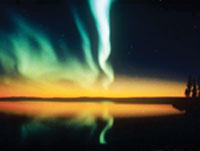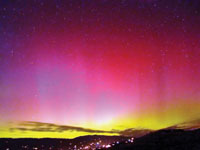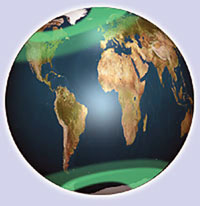
Northern lights moving across the sky
Northern lights... what do you know about them? Even if it is totally
alien to you, you are excused. Because, this magnificent view of the sky
occurs only almost once in 200 years, in the countries close to the
equator, like ours! Without wasting more words, let us tell you what
this is.
This is a light effect that colours the sky around the South and
North Poles. How do you think these colours originate?

The origin of Northern Lights also go to our Sun, just as all life.
During large explosions and flares or eruptions, huge quantities of
solar particles are thrown out of the Sun and into deep space.
These plasma clouds travel through space with speeds varying from 300
to 1000 kilometres per second. And do you know, even with such speeds,
it takes these plasma clouds around two to three days to reach our
planet?
When they get closer to the Earth, they are trapped by the Earth's
magnetic field which is called the magnetosphere (obviously, how can we
allow an alien object to enter our Earth?), and guided towards the
Earth's two magnetic poles; the geomagnetic South and North Poles.

On their way down, the solar particles are stopped by the Earth's
atmosphere, which acts as an effective shield against these deadly
particles.
When the solar particles are stopped by the atmosphere, they crash
with the atmospheric gases present, and the collision energy between the
solar particle and the gas molecule is emitted as a photon - a light
particle. And when you have many such collisions, you get an aurora or a
northern light - lights that may seem to move across the sky.

Here is the most amazing fact; in order for an observer to actually
see the aurora with the naked eye; about 100 million photons need to
gather.
Process of the Sun
As we mentioned earlier, the Sun is the energy source of these
Northern lights. The Sun or the burning gas globe has provided light and
warmth to the Earth for nearly five billion years.
The energy of the Sun generates in its inside, where the temperature
is believed to exceed 15 million degrees Kelvin(K), and the pressure is
also 250 billion times greater than on the Earth's surface.

This tremendous heat transforms hydrogen, the lightest element in the
known universe, into helium. The Sun's surface has a temperature of
approximately 5800 K.
The solar activity varies over periods of around 11 years. When the
number of spots peak, we call it as solar maximum; a solar minimum is
when the sunspot activity is low.
The more sunspots, the more solar particles are driven out into deep
space, and then more auroras occur on Earth. The latest solar maximum
was in 2001-2002, the next is expected some- time around 2011-2012.
Sunspots
Sunspots are patches created by strong magnetic fields on the surface
of the Sun. These areas are cooler than their surroundings (about 1000
degrees cooler), so, they appear darker. Sunspots are visual indications
of the process that send charged particles into space. These particles
may be captured by Earth's magnetic field to create the aurora.
Solar wind
A gas of electrons and ions - at supersonic speeds (refer to The
World of Science of November 19, 2006) - is continuously emitted from
the Sun. This stream of gas is called the solar wind.
|

The aurora oval |
The solar wind is filled with breezes and hurricanes, and when a
strong eruption from the Sun hits the Earth, the stable situation -
which may have existed for several days - is strongly disturbed. The
most spectacular result of this interaction is an intense aurora
significantly closer to the equator, which occurs once in 200 years,
than during normal conditions.
The aurora oval
The aurora zones are the places on Earth where auroras occur most
often and with the greatest intensity. It was first found by Swiss
physicist Herman Fritz (1829-1902).
He showed that the Northern lights have a maximum zone close to 67
degrees north and called this belt the aurora zone.
During the 1960s, the distribution of auroras were mapped. Then, it
was discovered that the auroras display a continuous oval zone around
the magnetic pole in both hemispheres.
The aurora oval can be regarded as fixed in space with reference to
the Sun. As the Earth revolves underneath, the daily variations in the
aurora's position occur. Modern studies have clearly shown that the
shapes and locations of the ovals vary greatly with solar activity.
With increasing activity on the Sun, the oval widens and spreads,
mainly towards the equator.
Read more about Northern lights in our next Geo facts page.
Janani Amarasekara
|
















